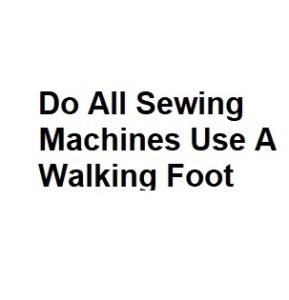Sewing machines are versatile tools used in various applications, from crafting and quilting to garment making and upholstery. One essential accessory for sewing machines is the walking foot, also known as a quilting foot or even-feed foot. However, not all sewing machines use a walking foot. In this article, we’ll explore what a walking foot is, its purpose, and which types of sewing machines typically require or benefit from its use.
What is a Walking Foot?
A walking foot is a specialized presser foot attachment used in sewing machines. It’s designed to feed multiple layers of fabric through the machine evenly and prevent fabric from shifting or bunching during stitching. The walking foot has a set of feed dogs (teeth-like mechanisms) on the top that work in conjunction with the machine’s lower feed dogs, allowing for smooth and consistent fabric movement.
Purpose of a Walking Foot:
The primary purpose of a walking foot is to assist in handling difficult or bulky fabrics and sewing projects. Here are some common reasons why you might use a walking foot:
- Quilting: Quilting involves sewing through multiple layers of fabric, batting, and often intricate patterns. A walking foot ensures even stitching and minimizes fabric distortion.
- Thick Fabrics: When sewing materials like denim, leather, or heavy canvas, a walking foot can help prevent uneven feeding, skipped stitches, or fabric puckering.
- Slippery Fabrics: Slippery fabrics such as satin, silk, or vinyl can be challenging to handle. A walking foot grips the fabric layers together, preventing slippage.
- Pattern Matching: When you need to match patterns or stripes precisely, a walking foot keeps the fabric layers aligned, reducing the chance of misalignment.
Types of Sewing Machines that Use Walking Foot:
While not all sewing machines require a walking foot, there are certain types and situations where using one is highly recommended or even essential:
- Industrial Sewing Machines: Many industrial sewing machines used in manufacturing, upholstery, and heavy-duty applications are equipped with walking feet as standard features.
- Quilting Machines: Dedicated quilting machines or sewing machines designed for quilting often come with a walking foot or are compatible with one.
- High-End Domestic Machines: Some high-end domestic sewing machines, especially those marketed to advanced or professional sewists, may include a walking foot or have it as an optional accessory.
- Specialized Machines: Sewing machines designed for specific tasks like leatherwork, sailmaking, or heavy-duty upholstery typically have walking feet.
Sewing Machines that Don’t Use Walking Foot:
Not all sewing machines require or support a walking foot attachment. These include:
- Basic Home Sewing Machines: Entry-level sewing machines for general household use typically don’t include a walking foot as part of their standard accessories.
- Serger Machines: Serger or overlock machines have their unique set of feed mechanisms and do not use walking feet.
- Vintage Machines: Older sewing machines may not be designed to accommodate modern walking feet, although some vintage models have compatible attachments available.
How to Use a Walking Foot:
If you have a sewing machine that supports a walking foot, here are some basic steps to follow when using it:
- Attach the Walking Foot: Turn off your sewing machine and remove the presser foot currently installed. Attach the walking foot by placing it on the presser bar and securing it with the presser foot holder.
- Engage the Walking Foot: Ensure that the walking foot mechanism is engaged properly. This often involves lowering the presser foot lever or following the instructions in your sewing machine’s manual.
- Thread the Machine: Thread your sewing machine as usual, including threading the needle and bobbin.
- Adjust the Tension: Depending on your sewing machine and fabric type, you may need to adjust the thread tension. Consult your sewing machine manual for specific recommendations.
- Test on Scrap Fabric: Before starting your actual project, it’s a good practice to sew a test piece on scrap fabric to ensure that the walking foot is working correctly and that the stitches are even.
- Sew Slowly: When using a walking foot, it’s often best to sew slowly, especially when dealing with challenging fabrics. This allows the walking foot to feed the fabric evenly and maintain stitch quality.
- Maintain Even Pressure: While sewing, keep an even pressure on the fabric without pushing or pulling it. Let the walking foot do the work of feeding the layers evenly.
- Practice and Familiarize: Using a walking foot may take some practice, especially if you’re new to it. Over time, you’ll become more comfortable and skilled in using this accessory effectively.
Conclusion:
A walking foot is a valuable tool for many sewing applications, but not all sewing machines require or come with one. Understanding when and how to use a walking foot can greatly improve your sewing experience and the quality of your projects, particularly when working with challenging fabrics or engaging in quilting and specialty sewing tasks. Always consult your sewing machine’s manual for specific guidance on using a walking foot with your machine, and don’t hesitate to seek advice from experienced sewists or professionals for tips and tricks to get the best results.
